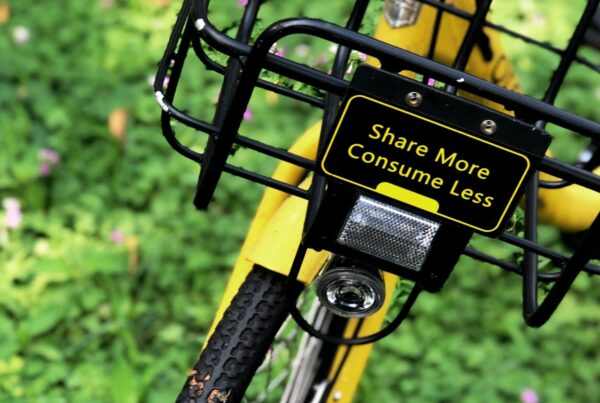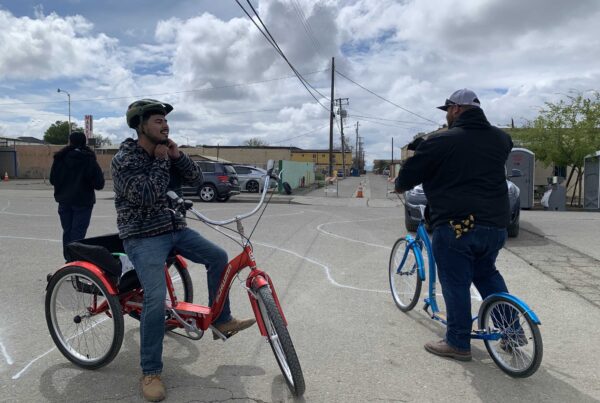Welcome to the Shared-Use Mobility Center’s weekly guide to the most impactful news, thought-provoking articles and innovative technologies that are shaping our transportation future. We believe in sharing information, just like sharing cars, bikes, and scooters, so if there’s anything additional you’d like to see, just drop us a line.
SUMC News and Announcements
Plug into more environmental benefits with updated Emissions Calculator
Last week we focused on telecommuting, this week it’s all about electrification, one of the many updates to the Shared Mobility Benefits Calculator on the MOD Learning Center. Now you can measure transit, carshare, and personal vehicle electrification as well as the impact of Shared Mobility Plus EVs.
 For example, without any other changes, replacing 75% of transit, carshare and personal vehicles with electric models in Los Angeles could save nearly 50,000 tonnes of CO2 in one year. Add shared mobility and total CO2 reduction tops 5,000,000 tonnes, and these benefits create a healthier world for us all.
For example, without any other changes, replacing 75% of transit, carshare and personal vehicles with electric models in Los Angeles could save nearly 50,000 tonnes of CO2 in one year. Add shared mobility and total CO2 reduction tops 5,000,000 tonnes, and these benefits create a healthier world for us all.
Intel for cities facing increased demands on curbs and sidewalks
Last week our friends at Populus, a data-driven mobility management platform for cities, released a new report on mobility and curb management. It contains a roundup of micromobility permits, fees, and incentive structures that have been adopted in cities and best practices for curb and mobility management.
For more information on how streets have evolved during the pandemic, take a look at our case study, Pop-up Mobility Paths and Open Streets due to COVID Crisis.
Fill up your event calendar with Federal Transit Administration
Stay in the know and connect with colleagues at roundtables, webinars, workshops, and more. View the calendar.
Mobility Justice
The suburbs, while commonly clichéd as one-dimensional, contain a wealth of racial, religious, and income-level diversity. Bloomberg CityLab sits down with writer Jason Diamond to discuss his book “The Sprawl: Reconsidering the Weird American Suburbs” and how they are ripe for mobility innovation.
COVID-19 hit Black and Brown communities on the South and West Sides the most in the Chicago metro area, which also happens to be where a large percentage of essential workers live. The Active Transportation Alliance analyzes how these disparities persist even with transportation access throughout these communities.
The City of Boston planned to remove around a quarter of the 500 trees on Melnea Cass Boulevard in the Roxbury neighborhood for a roadway plan that would have added two more lanes, creating more space for cars while removing necessary green space. The community’s residents, which are 90% people of color, denounced this plan as environmental racism and are now fighting back to keep the greenery.
How far do inequities in public transportation go? The Rice University Kinder Institute connects the dots on the way racism has historically shaped the way transit was funded, designed, and policed in American cities and how it dictates the way Black communities move now.
Ridehailing/Carsharing/Carpooling
The California Court of Appeal has granted Lyft and Uber a temporary stay to operate their ridehailing businesses in the state while the appeals process for the driver-employee classification is sorted out. And so it continues…
Chinese mobility company Didi Chuxing has launched its ridehailing service in the Russian city of Kazan, competing with local tech conglomerate Yandex’s local affair.
Toyota UK is bringing 25 Yaris Hybrids to Bristol as part of a collaboration with P2P carsharing platform Hiyacar.
A new P2P carsharing service called Avail Carsharing is slated for eight American cities (locations positioned near airports) with options for contactless pickup and drop-off.
Bikesharing and Micromobility
These two-page briefs from the Better Bike Share Partnership were extracted from a report documenting US bikeshare equity programs from 70 cities across 34 states—and how they help underserved communities.
Essential workers were left stranded once the pandemic hit and transit was reduced to slow the spread of COVID-19, so what did these commuters do? They looked at more shared mobility options and no longer rely on public transportation as the sole way to get to work.
E-bike sales are booming in the US as Americans find new ways to navigate their city streets, but Axios reports that shared e-bike usage from public and private operators still hasn’t recovered to pre-pandemic levels.
Toronto has started rolling out e-bikes for its bikeshare system that will see a total of 300 new pedal-assist bikes and 10 charging stations at the end of the full expansion.
Transit
VIDEO: Take a magical journey on the German “Wuppertal Schwebebahn” skytrain through this renovated, AI-enhanced footage shot in 1902.
From solar-powered bus shelters equipped with ultraviolet sterilizers to touch-free temperature-check kiosks, The World Economic Forum covers state-of-the-art COVID-19 response strategies that Asian countries are implementing for their busy public transportation networks.
The US’ single largest form of national mass transportation, the iconic school bus, is facing capacity challenges as schools implement social distancing strategies. What’s needed to reduce the strain on the yellow bus? More diverse travel patterns, particularly with better bike-to-school planning.
Transit agencies everywhere are fighting the ongoing pandemic to keep passengers and drivers safe while maintaining safe, reliable transportation. Read how the Seattle area is doing it in the Seattle Times.
Technology
Waymo is taking its self-driving tech to the freight industry in Texas with new plans to officially deploy autonomous trucks in the state.
A new hybrid freight train operated by railway company BNSF uses battery power generated from braking to cut emissions is being tested in California’s San Joaquin Valley along a 350-mile route.
An air filtration system that uses UV light and Photohydroionization, an advanced oxidation technology, is being tested for transit after studies showed it can potentially reduce airborne pathogens by 99%.
VIDEO: Researchers from various North American universities and the Singapore-ETH Centre developed a cooled shelter called the “Cold Tube” that uses water-chilled pipes and a humidity-repelling membrane to cool off humid environments, all while consuming less energy (with no emissions) than traditional A/C.
Sustainability
Read this excerpt from “Right of Way”, an upcoming book from former Streetsblog USA Editor and sustainable transportation advocate Angie Schmitt about the lack of pedestrian-centered policies in the US and how partisan politics almost completely made streets anti-pedestrian auto enclaves.
University of Washington researchers found that commercial vehicles cruising for parking accounted for 28% of the driver’s total trip time in downtown Seattle. Their solution? Demand-based parking rates and flexible curb space.
Poland is getting its first mobility hub which will combine shared dockless scooter, bike, and moped parking, dedicated EV charging, and mobility-as-a-service integration in the country’s largest business district in Warsaw.
Louisiana Governor John Bel Edwards has signed a new executive order that will chart a plan to hit net-zero carbon emissions by 2050 and transform the state’s energy sector to be more renewable.
Requests for Proposals, Inquiries, and Information
Operators for demand-responsive rideshare service
LA Metro
Los Angeles, California
Deadline: September 2, 2020
RFI: Mobility Services Partnerships
LA Metro
Los Angeles, CA
Deadline: September 4, 2020
RFP: Specialized ADA Transportation Services: Southern Region Los Angeles County
Access Services
Los Angeles, CA
Deadline: September 17, 2020
(Registration required)
RFI: Development of an RFP for a Statewide Mobility Services Program
New York State Department of Transportation
New York, New York
Deadline: September 21, 2020
Did someone forward this to you? Sign up for our newsletter here.



